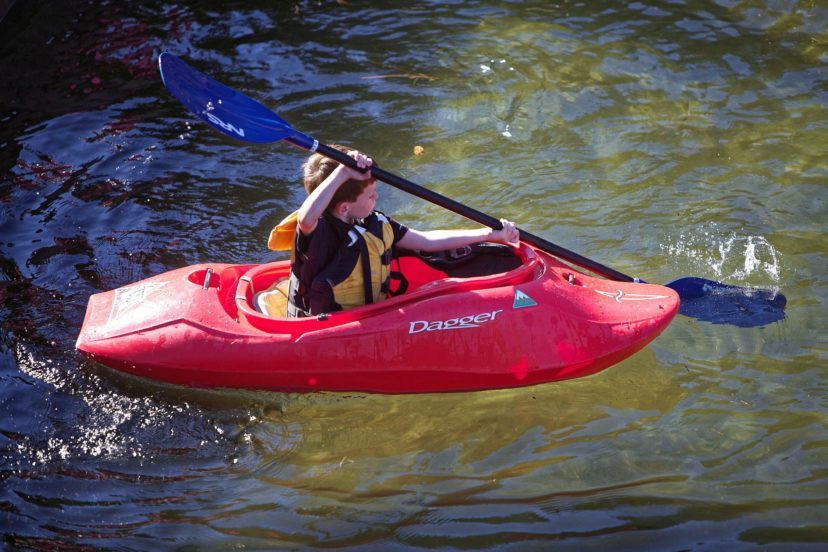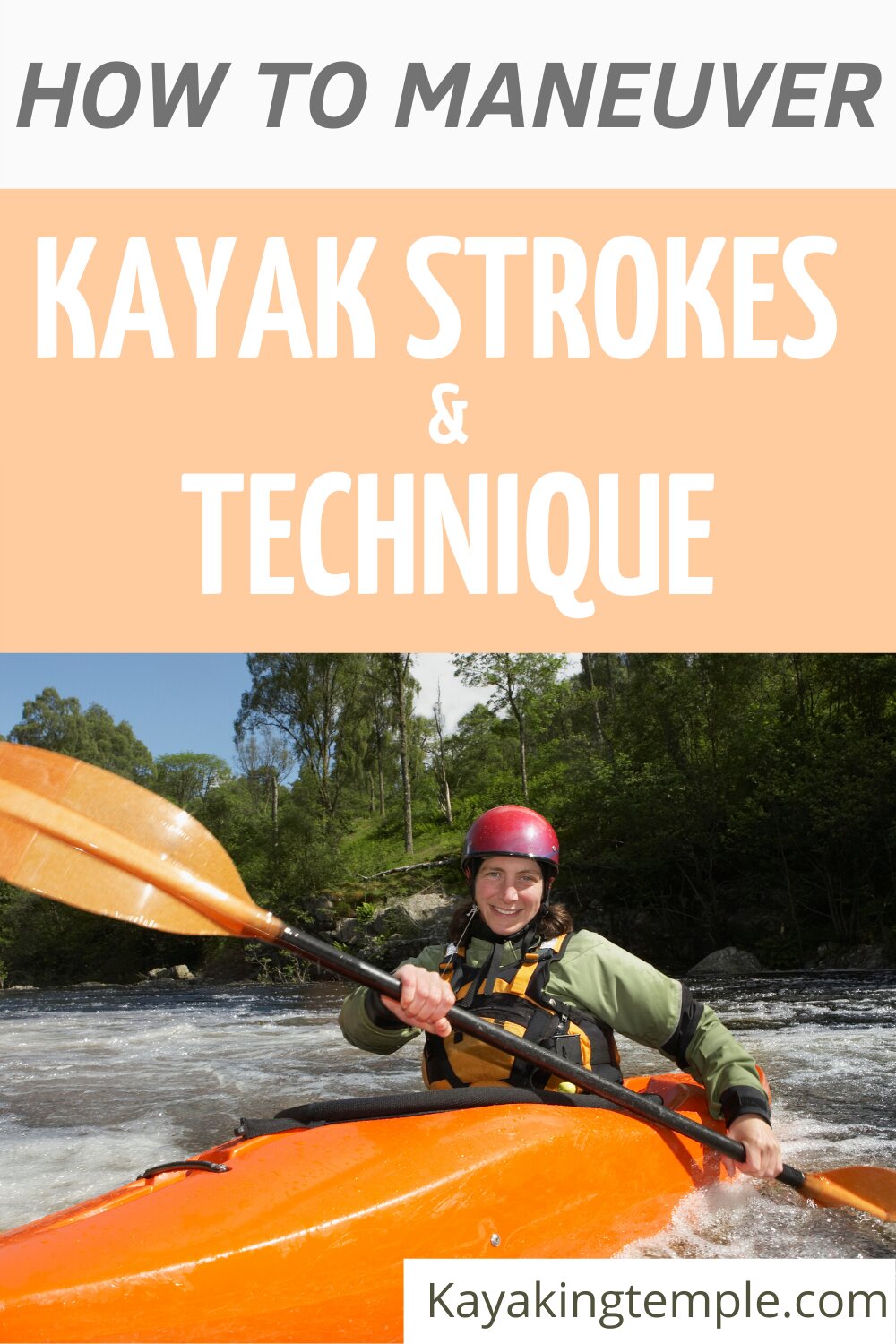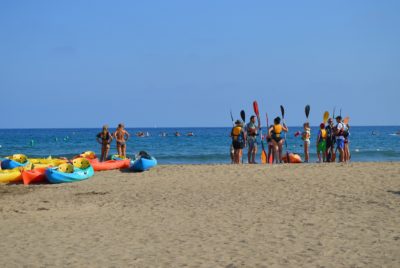How to Maneuver a Kayak: Basic Strokes

The good thing about flatwater kayaking is the ability to freely move anywhere on the water. Vital for exploration is the skill you use to control your kayak. By practicing some fundamental strokes, like the ones we are about to mention below, you can paddle properly and reach your final destination successfully.
In this article, I’ll go over all the basic tips on how you can control your kayak including:
- How to hold the paddle for proper stroking
- The forward stroke for propelling your kayak forward
- The reverse stroke for stopping and deceleration
- The sweeping stroke for maneuvering
- The draw stroke for scurrying your kayak to the sides
In case your kayak comes with a skag or a rudder, keep it out of the water as you learn to stroke. The aim here is to learn how to move in a straight line and maneuver based on this method. You’ll also get better results if you practice this method in tranquil and secure settings until you master it.
It would also be a smart idea to hire a seasoned kayak teacher or guide to show you the proper stroking methods. All this focus on details may sound a bit exaggerating but they are actually necessary when you take into account how many paddle movements you’ll have to do. Doing this in the wrong way will simply exhaust you faster.
The Right Paddle Grip
Gripping your paddle properly is vital for achieving a proper and non-tiring stroke. Make sure you also have a paddle that is the right length for your size. Gripping the paddle correctly includes four tips:
1. Identifying the type of blades your paddle has
2. Directing the blades in the right orientation
3. Repositioning the grip on the shaft
4. Loosening up your hands on the paddle shaft
1. What Kind of Blades Does Your Paddle Have?
- Are the blades parallel to each other or angled/feathered? It’s easier to practice with parallel blades. If your kayak’s blades are feathered though, check the center of the shaft for a button to press and holes surrounding the shaft. Push the button and turn the two halves of the shaft until the blades are finally aligned.
- Are the blades symmetrical or not? If one blade side is a tad shorter than the other, your blades are simply asymmetrical. The difference may be very small so check thoroughly. This asymmetrical form makes the paddle move straight through the water easier without spinning.If you notice that there is a perfect oval instead, your blades are symmetrical. You can practice paddling with either blade form but you need to identify which one you have in the first place.
- Are the blades a bit curved? In most cases, the answer is YES so check when the curved side is oriented when holding the shaft. This form will allow you to “hold” more water for a more robust stroke.
2. How To Direct Your Paddle Blades
Take a hold of your paddle, grip it forwards and check the following parameters:
- Make sure your big knuckles are facing up and your blades are at a 90-degree angle to the flat ground.
- Make sure the turned/concave side is pointing at you. This isn’t necessary if your blades are completely flat.
If you didn’t pick the paddle following this manner to the T, simply turn it around until the blades and your hands are facing in your preferred way.
3. Find the Right Point To Hold The Shaft
- Point the center of the paddle’s shaft to your forehead
- Then hold the shaft in a way so your hands are your shoulder-width apart from each other
When you push the paddle down forwards, you’ll get the “paddler’s box” a form that takes its shape form the shaft, your chest, and the arms. Keeping that box as you paddle through the water will help you move your torso properly, which is another key to a proper paddling method.
4. Loosen Up Your Grip
A loosened grip keeps your arms, wrists, and hands from getting tired. It’s also a reminder to lean upon your torso instead of putting force on your blades:
- Form a circle around the shaft using your thumb and index finger.
- Keep the rest of your fingers relaxed over the shaft.
Forward Stroke
The most basic paddling stroke, or in other words, the one you’ll have to practice the most requires more than arm power. It’s vital to use your toughest torso muscles to practice most of the stroke.
Examine the way you are gripping the paddle. Now, it’s time to move on to the three stages of forward stroking:
The catch stage: Curl your torso and plunge the blade entirely on one side of the kayak, right next to your legs.
The power stage: Turn your torso as the blade is propelled behind you. Visually keep track of the blade that is inside the water and your torso will naturally follow. Pay attention to the way you are pushing against the shaft using your upper hand as you stroke.
The release stage: When your hand is placed just behind your hip, “cut” the blade out the water. Repeat by simply submerging the blade out-of-the-water next to your legs.
Tips For A Better Technique:
- Pay attention to engaging your strongest core muscles to activate the stroke instead of your weaker arm muscles. Your muscles will wear off fast or become injured if you are not practicing the right stroking method.
- Keep the blade pointing at an almost vertical direction and a full level of submersion. This will allow you to stroke and turn quicker.
- Keep an upright position as much as you can so you can keep your balance and power.
- Check the paddler’s box throughout the movement so you can balance your body properly for every stage of the stroke.
The Reverse Stroke
Slowing down a kayak during movement is possible with the reverse stroke. It is the total opposite of the previous forward stroke method. If your kayak stands still, you can use the reverse stroking method to move it backward.
The dropping stage: Curl your torso and submerge the blade entirely on one side of the kayak, parallel to your hip.
The powring stage: Turn your torso so that the blade strokes to your front.
The release stage: Check that the paddle blade is at the same level as your feet and “cut” the blade out of the water.
Repeat by submerging the other blade on the opposite side of the kayak parallel to your hip. (your torso will already be positioned properly).
The Sweep Stroke
If you keep on doing forward strokes on one side of the kayak, you’ll notice that the kayak winds in the opposite orientation. A more effective way to turn the kayak around is to perform the sweeping stroke. Here is how you do it:
The catching stage: Stretch your arms to the front and submerge the blade next to your feet to begin sweeping. Start on the opposite side of the kayak from your preferred orientation.
The turning stage: Sweep the blade in a wide angle pointing to the stern of the kayak. Place a bit of force into your body’s turn to maximize the stroke, especially once the paddle is over the cockpit.
The release stage: Once the blade reaches the hull behind the cockpit, complete the stroke by cutting the blade off the water.
This will lead to a progressive rounded stroke with minimal momentum loss. You may repeat the sweeping motion if necessary or repeat your forward stroke.
Tip For A Better Technique:
It is important to do a broad sweep so visualize clock pointers in the water and aim to reach all the clock numbers along your curved path.
The Draw Stroke
You may use draw strokes to navigate your kayak to the sides. The draw stroke is handy when you need to pull close to another boat or dock. Here is how to do it:
1. Horizontally turn your paddle blade.
2. Stretch your hands with the blade’s tip to reach the water (approx. 2 feet distance) and right to the side of your kayak. Your paddle shaft should be properly angled.
3. Use your lower placed hand to pull the blade right in your front, while the blade’s tip remains submerged in the water during the movement.
4. Pause to prevent the blade from hitting the side of the kayak.
Usually, multiple draw strokes are necessary and this means you’ll have to resume the stroke:
- Turn the blade at a 90-degree angle and then cut it off the water to the sides.
- Perform steps 1 to 4 mentioned previously.
Tip For Better Safety:
In case the paddle hits one side of the kayak, avoid raising the blade out of the water as you’ll risk tipping and capsizing the kayak. If you still find it hits, just release the upper hand or loosen up your body and repeat.
How To Stop A Moving Kayak?
The simplest way to stop your boat is to just perform the reversed forward stroke. It’s totally reasonable if you think about it. Your boat propels forward and if you balance it out with a backward stroke, you will offset the movement so you can make your kayak finally stop and settle.
How To Keep Your Kayak In A Straight Line?
Learning how to keep your kayak straight isn’t a big priority compared to other methods. You just need to practice reaching your destination properly and then consider secondary stuff like this.
If you wish to maintain your kayak in a straight direction and sharpen your basic stroke skills, here is a list of the top 10 tips to consider in your next kayaking adventure.
You don’t have to recall all of these at once–you may start with practicing 2 tips at a time. Once you have worked your way up to tip 10, you will become a master at this.
- Mind your posture. Sit on your back sit bones and slowly get your belly button towards your spine
- Visualize having a fiver between the shoulder blades and keep this position.
- Make sure that your neck is fully stretched and your shoulders straight up, like a Ballerina.
- Begin with the bottom and push with the foot to begin the stroke.
- Grip the upper hand and avoid moving the top hand forward until the paddle is immersed in the water.
- Keeping a forward motion at all times, pay attention to drawing your hip and shoulder towards the seat.
- Cross-connection. Aim to form a connection between the upper shoulder and the opposite thigh throughout the stroke.
- Level running. Keep the upper hand at a similar level as you are stroking.
- Once your hand has passed your knee, ”slice” the blade out of the water so you and others don’t get wet.
- Avoid doing your next stroke until your backhand becomes the upper hand.
Once you familiarize yourself with these tips, keep on learning and practicing until you master the craft. You’ll be amazed on how fast your method and skills will be sharpened!
Like This Article? Pin it on Pinterest




